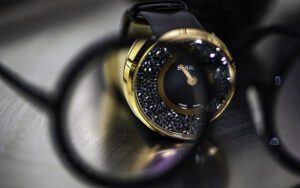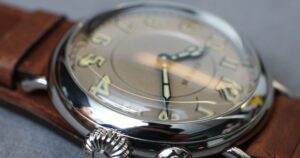A quality watchmaker uses several mechanisms to make a timepiece truly water-resistant or waterproof. It’s not just about sealing the inner workings from moisture intrusion. Different watches will have different levels of water-resistance to accommodate pressure changes and climate conditions, as well. Our watch aficionados wrote in to give us a closer look at how waterproof watches work. Read on to see what they had to say:
Table of Contents
ToggleTight Rubber Gasket Seal Between Case and Back of the Watch
Water-resistant watches are designed to protect the internal components from water damage. This is achieved by creating a tight seal between the case and the back of the watch. The seal is made of a special rubber gasket that is designed to keep water out. The gasket is usually made of a synthetic rubber material, such as silicone, which is resistant to water and other liquids.
The watch also has a crown, which is the part that you use to adjust the time. The crown is usually sealed with a screw-down system, which helps to keep water out. The screw-down system is designed to create a tight seal between the crown and the case. This helps to ensure that no water can enter the watch.
In addition, water-resistant watches are designed with a special coating that helps to protect the watch from water damage. This coating is usually made of a special material, such as titanium, which is resistant to water and other liquids.
Finally, water-resistant watches are designed with a special movement that is designed to be resistant to water. This movement is usually made of a special material, such as stainless steel, which is resistant to water and other liquids.
Screw-down Crowns and Case Constructions
Water-resistant watches employ various mechanisms and features to protect their internal components from water damage. The following elements contribute to their water resistance:
1. Sealing and Gaskets: Water-resistant watches feature seals and gaskets made from rubber or other materials to create a barrier between the case components. These seals are strategically placed at vulnerable points such as the crown, case back, and pushers to prevent water from entering.
2. Screw-down Crowns: Many water-resistant watches have screw-down crowns, which require twisting or unscrewing before adjusting the time or date. When tightly secured, the crown creates an additional layer of protection against water intrusion.
3. Case Construction: The case of a water-resistant watch is typically constructed to withstand water pressure. It may consist of multiple parts, including the case back, bezel, and crystal, that are tightly sealed together to form a watertight enclosure.
4. Crystal Materials: High-quality water-resistant watches often utilize synthetic sapphire crystals, which are exceptionally durable and resistant to scratches. The crystal is securely fitted to the case, contributing to the overall water resistance.
5. O-Ring Seals: O-rings, made of rubber or similar materials, are commonly used in water-resistant watches. These seals are placed around the case back, crown, and other openings to provide an additional layer of protection against water penetration.
6. Testing and Certification: Water-resistant watches undergo rigorous testing to determine their water resistance levels. They are tested under controlled conditions to measure their ability to withstand specific water pressures. The results determine the watch's water resistance rating, typically indicated in meters or ATMs (atmospheres).
It is important to note that water resistance is not a permanent feature and can deteriorate over time. Factors such as the aging of seals, accidental damage, or improper usage can compromise a watch's water resistance. Therefore, it is recommended to have water-resistant watches regularly inspected and serviced by authorized professionals to maintain their optimal performance.
By employing these design elements and ensuring proper maintenance, water-resistant watches can withstand exposure to water and moisture to a certain extent, allowing wearers to enjoy their timepieces without worrying about water-related damage.
Watch Face Is Protected by Durable Crystal
Water-resistant watches are specifically designed to keep water from infiltrating their internal mechanisms and damaging their components. The key features that enable water resistance in watches include:
1. Sealed case: A water-resistant watch has a sealed case that prevents water from entering. This is achieved by using gaskets or O-rings made of rubber, nylon, or Teflon, which create a watertight seal between the case and its components, such as the case back, crown, and crystal.
2. Screw-down crown and case back: Many water-resistant watches have a screw-down crown and case back, which provide additional protection against water ingress. The crown is the part used to set the time and date, while the case back covers the watch's movement. By screwing these components tightly into place, they form a secure seal that keeps water out.
3. Durable crystal: The crystal is the transparent cover that protects the watch face. Water-resistant watches typically use a durable material, such as sapphire or mineral glass, to withstand pressure and prevent water from seeping in.
4. Water-resistance rating: Watches are rated for their water resistance based on the depth they can withstand without damage. This is usually expressed in meters (e.g., 30m, 50m, 100m) or atmospheres (ATM). It's important to note that these ratings are based on laboratory testing under static pressure, so real-world performance may vary.
Here's a quick guide to water-resistance ratings:
● 30m / 3 ATM: Suitable for everyday use and can withstand splashes, but not suitable for swimming or diving.
● 50m / 5 ATM: Suitable for swimming, but not for diving or water sports.
● 100m / 10 ATM: Suitable for recreational surfing, snorkeling, and water sports, but not for scuba diving.
● 200m / 20 ATM and above: Suitable for professional marine activities, including scuba diving and deep-sea diving.
Gaskets, Screws, Crystals and Lubricants and Special Materials
Modern water-resistant watches are designed to protect against the ingress of liquids, including water, dirt, and dust. They usually feature a rubber gasket that seals the watch case and secures the back cover. This gasket is designed to form a vacuum seal when the watch is closed, effectively preventing any liquids from entering. Additionally, many watches feature a screw-down crown, which further helps to keep water out. This is because the screw-down crown adds extra pressure to the gasket and creates a tighter seal.
To keep out dust, some watches are equipped with a sapphire crystal. Sapphire is renowned for its hardness and scratch-resistant qualities, making it a perfect choice for watch crystals. In addition, some watches are coated with a thin film of lubricant or oil, which can help to reduce friction between the moving parts of the watch and prevent dust from entering the inner workings of the watch.
Finally, some watches are made with special materials that are designed to repel liquids. These materials are usually hydrophobic and can help to reduce the amount of moisture that penetrates the watch case. For example, some watches are made with special coatings that repel liquids or contain microscopic spheres that deflect any incoming liquids.
Overall, water-resistant watches are designed to protect against liquids and dust. By using a combination of gaskets, screws, crystals, lubricants, and special materials, water-resistant watches are able to effectively keep out any liquids that attempt to penetrate the case.
Measure in ATMs or Atmospheres
Water-resistant watches are designed to be able to withstand a certain amount of water pressure and moisture without being damaged. The water resistance of a watch is measured in ATM, which stands for atmosphere. An atmosphere is a unit of pressure, and one ATM is equal to 10 meters of water pressure.
Most watches are designed to be water-resistant up to a certain point, usually 3 to 5 ATMs. This means that they can be submerged in water up to 30 to 50 meters deep without being damaged. However, it is important to note that this is only true for a limited amount of time. After a certain amount of time, the water resistance of the watch may start to deteriorate, and it may need to be serviced or replaced.
It is also important to note that water-resistant watches need to be properly maintained to remain effective. This includes checking the seals and gaskets regularly to make sure they are still intact and not damaged. Additionally, it is important to make sure that the watch is not exposed to extreme temperatures or chemicals, as this can also affect its water resistance.
This is a crowdsourced article. Contributors' statements do not necessarily reflect the opinion of this website, other people, businesses, or other contributors.








